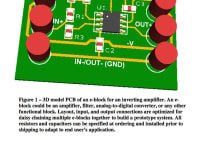An e-block is an electronic block, a “lego” piece of electronics. One can order pieces of e-blocks and snap them together to build a working device in a matter of hours. This modular concept to building electronics enables engineers, hobbyists, and researchers alike to build customized, yet modular and off-the-shelf, electronic systems at a fraction of the time and cost of designing a conventional prototype board.
The idea works because many electronic designs share common architectures. For example, most data acquisition systems have a sensor that measures a physical property, an analog front end that conditions the signal, analog-to-digital conversion, a processing unit (microcontroller or FPGA or both), an input unit (keyboard, button), a display unit (LCD, 7-segment LEDs, or PC), and memory. Within each subsystem, a set of circuit topologies are used over and over. Amplifiers are classified into charge, current, or voltage amplifiers, be it single-ended or differential. Filter types are low pass, high pass, band pass, or band stop of one to a few orders Butterworth, Chebychev, or other topologies. ADC’s interfaces also tend to follow a few standards, be it parallel or serial. MCU’s and FPGA’s can have every pin routed to a test point, and, with minimal “green wiring” to other e-blocks, is often used to sample a few analog voltages, turn on and off some switches, interface with a few devices via SPI/IUART/I2C/CAN/USB, and drive a few things with DAC or PWM.
Each of the above subsystems could potentially be replaced with an e-block. Several e-blocks can be daisy chained together to make a system. Different applications will require different parameters for the blocks, and that can be customized at time of ordering. For example, a low pass filter e-block can have its unique resistor and capacitor values installed just prior to shipping to the end user.
Although it is impossible to come up with infinite blocks that all fit together to serve every imaginable purpose, there are undoubtedly many potential applications. For a professional design engineer, e-blocks serve as a fast prototype to help with early concept validation or get a head start on writing firmware. For a hobbyist who may not have the time, money, or knowledge to design and order low quantities of prototype boards, e-blocks literally works right out of the box to make the intended measurement for further tinkering. For a university researcher or student, e-blocks provides fast, low cost, and adequate engineering support to enable him or her to focus on the scientific research of interest.
In conclusion, e-blocks is a novel concept to building electronic prototypes. It is a collection of small electronic modules (“lego” pieces) that are the building blocks of most common electronic systems. These building blocks have cleverly arranged input and output connections to allow them to be daisy chained together, either as is or with minimal external wiring to yield a complete system. E-blocks is a fast and modular prototyping system that has the potential to accelerate technology development and research.
Like this entry?
-
About the Entrant
- Name:Thientu Ho
- Type of entry:individual
- Patent status:none





